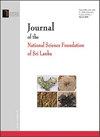Risk assessment of heavy metals in the freshwater lake sediments around Eppawala phosphate deposit, Sri Lanka
IF 0.4
4区 综合性期刊
Q4 MULTIDISCIPLINARY SCIENCES
Journal of the National Science Foundation of Sri Lanka
Pub Date : 2024-01-02
DOI:10.4038/jnsfsr.v51i4.11473
引用次数: 0
Abstract
The Eppawala area in Sri Lanka has an agricultural-based economy. As a result, the recent agricultural intensification could increase the risk of heavy metal contamination in lakes in the area as the main water canal in the area, i.e., Jaya Ganga, flows across these lakes. Therefore, this study focuses on the risk assessment of heavy metals in the freshwater lake sediments in the Eppawala area and the identification of potential sources for heavy metal contamination in the lakes. Nine heavy metals (Cr, Mn, Co, Ni, Cu, Zn, As, Cd, and Pb) were investigated in surface sediments (n = 22) of the upstream and downstream lakes of the Eppawala Phosphate Deposit (EPD). The average heavy metal concentrations in the upstream lake sediments were higher than those downstream. Eppawala lake sediments were heavily polluted by As along with moderate to high Cr pollution. However, only As and Cd indicated considerable to moderate ecological risk levels to the local environment. The downstream lake sediments showed lower heavy metal contents compared to those upstream and had negative correlations between heavy metals and P2O5 contents. This reveals that the EPD does not contribute to the heavy metal contamination in the Eppawala lake sediments. However, the statistical analysis showed that heavy metals were mostly derived from similar pollution sources. Agrochemicals used in paddy cultivation in the vicinity might be a potential source of heavy metals. This study highlights the importance of implementing remediation to control the heavy metal pollution prevailing in the Eppawala lakes.斯里兰卡埃帕瓦拉磷酸盐矿床周围淡水湖沉积物中重金属的风险评估
斯里兰卡埃帕瓦拉地区的经济以农业为主。因此,最近的农业集约化可能会增加该地区湖泊的重金属污染风险,因为该地区的主要水渠(即 Jaya Ganga)流经这些湖泊。因此,本研究的重点是对埃帕瓦拉地区淡水湖沉积物中的重金属进行风险评估,并确定湖泊中重金属污染的潜在来源。研究调查了埃帕瓦拉磷酸盐矿床(Eppawala Phosphate Deposit,EPD)上游和下游湖泊表层沉积物(n = 22)中的九种重金属(铬、锰、钴、镍、铜、锌、砷、镉和铅)。上游湖泊沉积物中重金属的平均浓度高于下游湖泊。埃帕瓦拉湖沉积物受到严重的砷污染和中度到高度的铬污染。不过,只有砷和镉对当地环境造成了相当大到中等程度的生态风险。与上游相比,下游湖泊沉积物的重金属含量较低,且重金属与 P2O5 含量呈负相关。这表明,环保署并没有造成埃帕瓦拉湖沉积物中的重金属污染。不过,统计分析显示,重金属大多来自相似的污染源。附近水稻种植中使用的农用化学品可能是重金属的潜在来源。这项研究强调了采取补救措施控制埃帕瓦拉湖重金属污染的重要性。
本文章由计算机程序翻译,如有差异,请以英文原文为准。
求助全文
约1分钟内获得全文
求助全文
来源期刊

Journal of the National Science Foundation of Sri Lanka
MULTIDISCIPLINARY SCIENCES-
CiteScore
0.90
自引率
0.00%
发文量
57
审稿时长
>12 weeks
期刊介绍:
The Journal of National Science Foundation of Sri Lanka (JNSF) publishes the results of research in Science and Technology. The journal is released four times a year, in March, June, September and December. This journal contains Research Articles, Reviews, Research Communications and Correspondences.
Manuscripts submitted to the journal are accepted on the understanding that they will be reviewed prior to acceptance and that they have not been submitted for publication elsewhere.
 求助内容:
求助内容: 应助结果提醒方式:
应助结果提醒方式:


